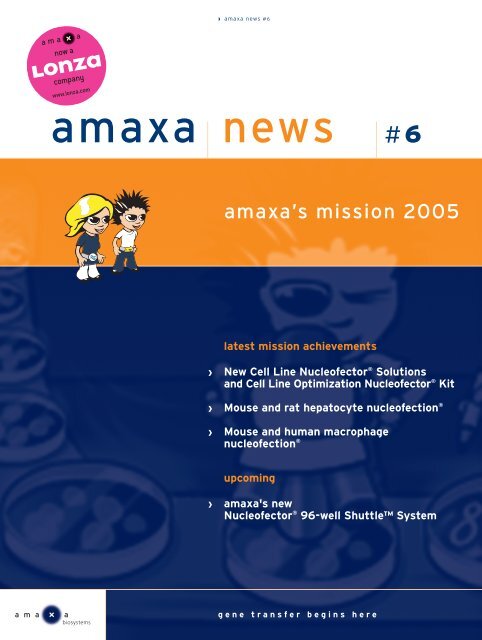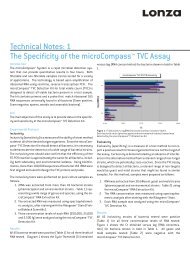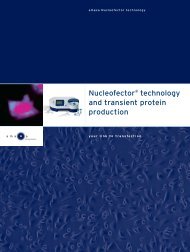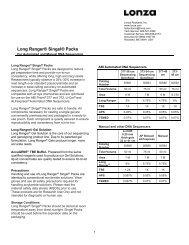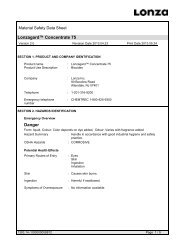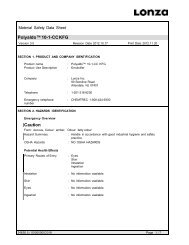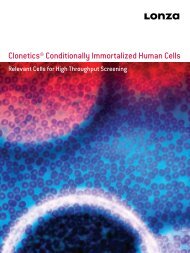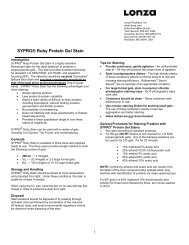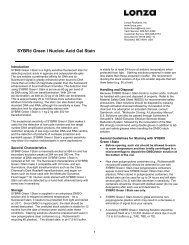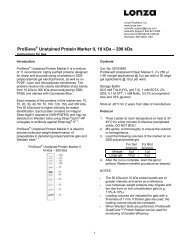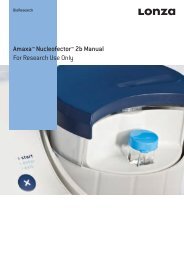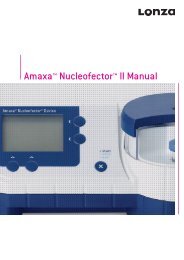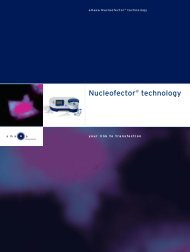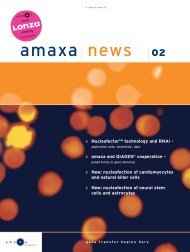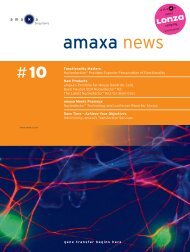Amaxa news #6 - lonza
Amaxa news #6 - lonza
Amaxa news #6 - lonza
Create successful ePaper yourself
Turn your PDF publications into a flip-book with our unique Google optimized e-Paper software.
amaxa<br />
› amaxa <strong>news</strong> # 6<br />
<strong>news</strong><br />
latest mission achievements<br />
gene transfer begins here<br />
# 6<br />
amaxa’s mission 2005<br />
› New Cell Line Nucleofector ® Solutions<br />
and Cell Line Optimization Nucleofector ® Kit<br />
› Mouse and rat hepatocyte nucleofection ®<br />
› Mouse and human macrophage<br />
nucleofection ®<br />
upcoming<br />
› amaxa's new<br />
Nucleofector ® 96-well Shuttle System
96-well<br />
transfection<br />
Introducing:<br />
amaxa's new Nucleofector ®<br />
96-well Shuttle System<br />
› applicable for cDNA and RNAi library<br />
screening in primary cells and difficultto-transfect<br />
cell lines<br />
› up to 90% transfection efficiency with<br />
DNA<br />
› up to 99% transfection efficiency with<br />
siRNA duplexes<br />
Pre-register now: available Q 1, 2006!<br />
amaxa Europe /Export<br />
scientific-support@amaxa.com<br />
+49 (0) 221 99199-400<br />
amaxa Europe /Export<br />
amaxa USA<br />
scientific-support.US@amaxa.com<br />
240-632-9110<br />
Editorial<br />
We have dedicated this issue of amaxa <strong>news</strong> to report on some of<br />
our latest accomplishments, ranging from new protocols and kits<br />
for additional cell types and applications, such as protein production,<br />
to nucleofection in a 96-well format.<br />
In the field of primary cell transfections, we have tackled two cell<br />
types that have so far been impossible to efficiently transfect with<br />
non-viral methods: macrophages (human and mouse, see pages<br />
14-15) and hepatocytes (mouse and rat, see pages 6-7).<br />
For cell line transfections you will find not only a steadily increasing<br />
number of Optimized Protocols but also two new Cell Line Nucleofector<br />
Kits. As shown on pages 4-5, transfection efficiencies of<br />
60-80% are achieved in cell lines such as MDCK, NS0, BHK-21,<br />
EL-4, WEHI-231 etc.<br />
In 2006, we shall continue providing you with the latest cuttingedge<br />
transfection technology. Our upcoming Nucleofector 96-well<br />
Shuttle System (introduced on pages 12-13) is further proof of our<br />
ongoing commitment to provide the best transfection solutions.<br />
Soon you will be able to perform high-throughput transfections in<br />
primary cells, such as T cells, or virtually any difficult-to-transfect<br />
cell line. Like the Nucleofector, the new Nucleofector 96-well Shuttle<br />
System delivers cDNA, siRNA as well as shRNA libraries into your<br />
cell of interest with highest efficiency. Take a look at our new developments<br />
to help you meet your personal research mission in 2006.<br />
Rainer Christine<br />
CEO
Editor<br />
Wolfgang Kintzel<br />
New products<br />
New products<br />
Technote<br />
Product update<br />
Hot topic<br />
New products<br />
New products<br />
Hot topic<br />
New products<br />
amaxa insights<br />
amaxa insights<br />
amaxa insights<br />
FAQ<br />
amaxa insights<br />
Editorial board<br />
Martina Mohrs, Oliver Gresch,<br />
Katrin Höck, Andrea Toell<br />
Production coordinator<br />
Petra Schmid<br />
amaxa <strong>news</strong> is published by<br />
amaxa GmbH<br />
Nattermannallee 1<br />
50829 Koeln<br />
Germany<br />
amaxa_<strong>news</strong>@amaxa.com<br />
Tel: +49(0)221-99199-0<br />
Fax: +49(0)221-99199-111<br />
› Table of contents<br />
› page 3 › www.amaxa.com<br />
4 Nucleofection ® of cell lines further improved<br />
6 Mouse and rat hepatocyte nucleofection ®<br />
8 Use of Nucleofector ® technology for transient protein production<br />
Markus Zumbansen, Stefanie Zahn, Oliver Gresch, Andreas Herrmann and Titus Kretzschmar<br />
10 Is your Nucleofector ® Software up-to-date?<br />
11 Understanding cell-matrix contacts with the help of nucleofection ®<br />
Stefan Linder<br />
12 High-throughput transfection<br />
Introducing amaxa’s Nucleofector ® 96-well Shuttle System<br />
14 Efficient non-viral transfection of human and<br />
mouse macrophages<br />
16 Essentials for the nucleofection ® of mouse T cells<br />
17 amaxa’s Basic Nucleofector ® Kits<br />
Broad-range nucleofection ® at its best<br />
18 amaxa’s online information pool is growing<br />
19 Representing amaxa in Canada – ESBE Scientific<br />
20 Scientific Product Specialists: On the road all around the world<br />
22 Frequently asked questions about achieving high viability<br />
pre and post nucleofection ®<br />
23 Meet amaxa in 2005/2006<br />
Please note that to date amaxa’s Nucleofector ® technology is intended for research or investigational<br />
use only.<br />
amaxa's Nucleofector ® Process, Nucleofector ® Device and Nucleofector ® Solutions are covered by<br />
PCT Applications PCT/EP01/07348, PCT/DE02/01489, PCT/DE02/01483, and other pending<br />
patents, and domestic or foreign applications corresponding thereto. The Nucleofector ® 96-well<br />
Shuttle System is covered by patent and/or patent-pending rights owned by amaxa.<br />
amaxa, gene transfer begins here, Nucleofector, nucleofection, Nucleocuvette, 96-well Shuttle<br />
and maxGFP are trademarks of amaxa GmbH. EndoFree is a trademark of Qiagen. Steady-Glo is a<br />
trademark of Promega. Lipofectamine 2000 and Gibco are trademarks of Invitrogen. SpectraMax ®<br />
is a trademark of Molecular Devices. Other product and company names mentioned herein are the<br />
trademarks of their respective owners.<br />
Design<br />
vierviertel – Agentur für Kommunikationsdesign GmbH<br />
info@vierviertel.com<br />
© September/2005 amaxa. All rights reserved. Printed in Germany.
› New products<br />
100<br />
90<br />
80<br />
70<br />
60<br />
50<br />
40<br />
30<br />
20<br />
10<br />
0<br />
new<br />
Nucleofection ® of cell lines<br />
further improved<br />
amaxa’s dedication to help you succeed in your research by providing easy and reliable transfection<br />
solutions has led to the creation of a wide range of Optimized Protocols for standard and difficult-totransfect<br />
cell lines. To date amaxa’s Cell Database comprises information on the successful<br />
transfection of more than 300 cell lines. Our commitment to provide the optimal approach for your<br />
cell line transfection, has resulted in two additional new Cell Line Nucleofector Solutions.<br />
Furthermore a redesign of our Cell Line Optimization Nucleofector Kit, makes your cell line optimization<br />
even quicker, more convenient and economic than before.<br />
A10 CCRF FDC-P1 MDCK WEHI-231 EL-4<br />
Fig. 1: Average transfection efficiencies and viabilities for<br />
cell lines transfected with the new Cell Line Nucleofector<br />
Solution C and L. All cells were transfected with pmaxGFP.<br />
24 h post nucleofection transfection efficiencies were determined<br />
by flow cytometry. Viabilities are either given as % PI negative<br />
cells (CCRF-CEM, FDC-P1, WEHI-231, EL-4) or compared to unnucleofected<br />
controls (A10, MDCK). A10, FDC-P1, MDCK, WEHI-231<br />
and EL-4 cells were transfected using Cell Line Nucleofector Kit<br />
L, CCRF-CEM cells with Kit C.<br />
100<br />
90<br />
80<br />
70<br />
60<br />
50<br />
40<br />
30<br />
20<br />
10<br />
0<br />
BHK-21<br />
efficiency viability<br />
efficiency viability<br />
Fig. 2: Average transfection efficiencies and viabilities<br />
of cell lines BHK-21 and NS0 cells, also used for protein<br />
production. BHK-21 and NS0 cells were transfected with<br />
pmaxGFP. 24 h post nucleofection transfection efficiencies and<br />
viabilities were determined by flow cytometry (viability = % PI<br />
negative cells). BHK-21 cells were transfected with Cell Line<br />
Nucleofector Kit L, NS0 cells with Kit C.<br />
› page 4 › amaxa <strong>news</strong> # 6<br />
NS0<br />
C and L: Two new Cell Line Nucleofector ® Solutions to<br />
advance your cell line transfections<br />
In addition to the existing Cell Line Nucleofector Solutions R, T<br />
and V two new solutions are now available to further extend the<br />
range of cell lines that can be successfully transfected. By screening<br />
many new possible solutions, amaxa’s R&D team has identified<br />
two new Cell Line Nucleofector Solutions, named C and L.<br />
These have shown superior transfection results compared to the<br />
existing solutions: over 60% for eight newly developed cell line<br />
optimization protocols (Fig. 1 and 2). Transfection efficiencies<br />
were thus frequently more than 20% higher than those achieved<br />
with the existing solutions (data not shown).<br />
Highly efficient transfection of optimization protocols cell<br />
lines NS0 and BHK-21, also used for protein production<br />
With the new Cell Line Nucleofector Solutions it is now possible to<br />
transfect NS0 and BHK-21 cells, both of which are frequently used<br />
for mammalian protein expression culture (also see pages 8-10 to<br />
learn more about protein production in mammalian cells using<br />
the Nucleofector technology). With Cell Line Nucleofector Solutions<br />
C and L transfection efficiencies of over 80% can be achieved<br />
for both NS0 and BHK-21 cells, with viabilities ranging from<br />
50-90% (Fig. 2). The Optimized Protocol for NS0 cells enables<br />
efficient transfection of NS0 cultured under serum-free conditions<br />
(Fig. 3).
[k]<br />
d<br />
› New products<br />
A<br />
B<br />
Fig. 3: Example of the transfection of NS0 with<br />
pmaxGFP cultured under serum-free conditions.<br />
› page 5 › www.amaxa.com<br />
A new version of our Cell Line Optimization Nucleofector Kit –<br />
making cell line transfection in your lab even quicker and more<br />
convenient than before<br />
For transfection of your cell line of interest you can rely on either<br />
detailed Optimized Protocols for cell lines optimized by amaxa or<br />
on our online Cell Database which provides information from<br />
other users. For any other cell line, where there are no nucleofection<br />
details available, the Cell Line Optimization Nucleofector Kit<br />
is the method of choice. With the use of this comprehensive<br />
approach you can transfect virtually any cell line. In addition we<br />
have improved our current Cell Line Optimization Nucleofector<br />
Kit (Fig. 4). The result is an even quicker and more convenient<br />
tool to successfully transfect your cell line of choice.<br />
The new Cell Line Optimization Nucleofector Kit is:<br />
quick › only 18 transfections (including controls) required for the first<br />
optimization round<br />
convenient › now with just two Nucleofector Solutions for easier handling<br />
economic › fewer cells required for optimization<br />
1 Solution V L<br />
program 1 A-020 A-020<br />
program 2 T- 020 T- 020<br />
program 3 T- 0 30 T- 0 30<br />
program 4 X-001 X-001<br />
program 5 X-005 X-005<br />
program 6 L- 0 2 9 L- 0 2 9<br />
program 7 D-023 D-023<br />
Fig. 4: The new Cell Line Optimization Nucleofector Kit with just 18 reactions. The kit contains Cell Line Nucleofector Solutions V and L. In<br />
combination with a new range of Nucleofector Programs you can achieve superior transfection results for virtually any cell line. This new cell line<br />
optimization approach reduces the number of transfections that need to be done by almost 50%. For further optimization, our expert Scientific<br />
Support Team is, of course, available to provide you with advice on how to improve your transfection results even further.<br />
Ordering information<br />
Cell Line Nucleofector ® Solution R Cat. No.: VCA-1001 Cell Line Nucleofector ® Solution C Cat. No.: VCA-1004<br />
Cell Line Nucleofector ® Solution T Cat. No.: VCA-1002 Cell Line Nucleofector ® Solution L Cat. No.: VCA-1005<br />
Cell Line Nucleofector ® Solution V Cat. No.: VCA-1003 Cell Line Nucleofector ® Optimization Kit Cat. No.: VCO-1001*<br />
amaxa web information www.amaxa.com/celldatabase<br />
2 3<br />
> > > +<br />
> > ><br />
Step 1 The cell line of interest<br />
is transfected with the<br />
Nucleofector solutions V<br />
and L in combination with<br />
seven different Nucleofector<br />
programs.<br />
Step 2 The Nucleofector<br />
solution and program which<br />
result in highest transfection<br />
efficiency and viability<br />
are selected.<br />
*available Nov 1 st , 2005<br />
Step 3 Further optimization<br />
of the nucleofection<br />
conditions can be performed<br />
with the help of our<br />
Scientific Support Team.
› New products<br />
new<br />
Benefit from:<br />
Mouse and Rat Hepatocyte<br />
nucleofection ®<br />
Our R&D team has set out to conquer yet another untransfectable cell type: primary hepatocytes.<br />
This quest has resulted in specific Nucleofector Kits for mouse and rat hepatocytes.<br />
First non-viral transfection of hepatocytes › Ability to use primary hepatocytes for toxicologic studies<br />
Reliable performance › Up to 55% efficiency in mouse and rat hepatocytes<br />
Functionality › albumin synthesis rates of nucleofected cells comparable to<br />
transfection efficiency<br />
› page 6 › amaxa <strong>news</strong> # 6<br />
% transfected cells<br />
those of untransfected control<br />
Flexibility › suitable for DNA and siRNA<br />
Due to their low ability to proliferate efficient<br />
transfection of primary hepatocytes has so far<br />
been restricted to virus-based protocols. amaxa<br />
is now introducing Nucleofector Kits for mouse<br />
and rat hepatocytes. A protocol for human<br />
hepatocytes will follow soon. With these new<br />
kits, efficient and reproducible transfection of<br />
primary hepatocytes is possible for the first<br />
time. Efficiencies of up to 55% can be achieved<br />
while cells remain functional. Once again the<br />
Nucleofector technology offers the only efficient<br />
and reproducible non-viral transfection<br />
method for these cells. Fig. 1 summarizes transfection<br />
efficiencies for primary hepatocytes.<br />
Furthermore, the siRNA Test Kit has successfully<br />
been used. Fig. 2 shows downregulation of<br />
maxGFP expression in mouse hepatocytes.<br />
100<br />
90<br />
80<br />
70<br />
60<br />
50<br />
40<br />
30<br />
20<br />
10<br />
0<br />
mouse<br />
rat<br />
viability<br />
Fig. 1: Average transfection efficiencies and viabilities of mouse and rat<br />
hepatocytes 24 hours post nucleofection with pmaxGFP TM .<br />
% living cells (trypan blue negative)<br />
A B<br />
100<br />
90<br />
80<br />
70<br />
60<br />
50<br />
40<br />
30<br />
20<br />
10<br />
0<br />
C D<br />
mouse<br />
Fig. 2: Efficient gene silencing in mouse hepatocytes. Hepatocytes were nucleofected<br />
with 2 μg of pmaxGFP (A,B) or cotransfected with 2 μg pmaxGFP and<br />
1.5 μg siRNA directed against maxGFP (C,D). 24 hours post nucleofection cells were<br />
analyzed by light and fluorescence microscopy for maxGFP expression.<br />
rat
[k]<br />
coming soon<br />
› New products<br />
Nucleofected mouse and rat hepatocytes maintain their functionality<br />
Hepatocytes are involved in numerous metabolic pathways and have important functions that include detoxification,<br />
synthesis of proteins, lipids and bile acids as well as storage of glycogen and vitamins. Thus, primary hepatocytes are<br />
frequently used tools to study mechanisms of cell growth and differentiation, drug pharmacokinetics as well as<br />
biotransformation and toxicity of drugs. The Nucleofector technology will help you gain further insight into these and<br />
other research topics. Figs. 3 and 4 demonstrate that transfected hepatocytes remain functional. Mouse hepatocytes<br />
show albumin secretion rates comparable to those of untransfected control hepatocytes (Fig. 3). Fig. 4 proves that rat<br />
hepatocytes show normal cell-cell interactions and formation of bile canaliculi post nucleofection.<br />
albumin secretion [pg/cell/hour]<br />
0.25<br />
0.2<br />
0.15<br />
0.1<br />
0.05<br />
0<br />
untreated cells<br />
nucleofected cells<br />
Fig. 3: Nucleofected hepatocytes maintain functionality.<br />
24 hours post plating cultured and nucleofected primary<br />
mouse hepatocytes were analyzed for albumin secretion<br />
(normalized to cell number) by ELISA.<br />
Ordering information<br />
Mouse Hepatocyte Nucleofector ® Kit Cat. No.: VPL-1002<br />
Rat Hepatocyte Nucleofector ® Kit Cat. No.: VPL-1003<br />
Human Hepatocyte Nucleofector ® Kit Cat. No.: VPL-1001<br />
› Product update<br />
Top<br />
offer<br />
A<br />
Fig. 4: Nucleofected hepatocytes maintain their morphology and polarization.<br />
Primary rat hepatocytes were nucleofected with pmaxGFP (A) or a plasmid containing<br />
the cDNA sequence for a plasma membrane receptor-YFP fusion protein (B).<br />
Hepatocytes were stained with antibodies against desmoplakin (A; blue) to visualize<br />
cell boundaries, and against multidrug resistance protein 2 (MRP2; A+B; red) to show<br />
the apical, canalicular membrane. maxGFP was located in the cytosol of transfected<br />
cells (A). YFP-fusion protein was correctly targeted to both the basolateral and the<br />
apical membrane domain as shown by colocalization with MRP2 (B).<br />
(Data courtesy of V. Keitel, F. Schliess and D. Häussinger, Clinic for Gastroenterology,<br />
Hepatology and Infectiology, Heinrich-Heine-University Düsseldorf, Germany)<br />
q<br />
d<br />
N<br />
N<br />
*<br />
*<br />
N = nuclei; * = bile canaliculi<br />
N<br />
N<br />
B<br />
Supplementary information Gastroenterology Flyer<br />
amaxa web information www.amaxa.com/gastroenterology.html<br />
Trade in your Nucleofector ® I for<br />
a Nucleofector ® II at low cost<br />
and benefit from<br />
› a two-year warranty extension<br />
› virtually unlimited filing capacity for new Nucleofector programs<br />
› compatibility with upcoming new applications such as our Nucleofector ® 96-well Shuttle System<br />
› possibility to store your individually identified cell-type program<br />
For more information contact your local sales representative or fill out the reply card in the center of this <strong>news</strong>letter.<br />
› page 7 › www.amaxa.com<br />
*<br />
N<br />
*
› Technote<br />
1 amaxa GmbH,<br />
Köln, Germany<br />
2 Celonic GmbH,<br />
Jülich, Germany<br />
Use of Nucleofector ® technology<br />
for transient protein production<br />
Markus Zumbansen 1 , Stefanie Zahn 2 , Oliver Gresch 1 , Andreas Herrmann 2 , Titus Kretzschmar 1<br />
Mammalian cells are often the only possible protein expression system when it comes to recombinant expression of<br />
complex proteins such as antibodies. While generation of stably expressing cell clones is usually the method-of-choice,<br />
transient protein production in mammalian cell cultures is becoming more popular as it offers a quick and affordable<br />
alternative to establishing stable clones. Here we describe the successful use of the Nucleofector technology to<br />
transiently express proteins in difficult-to-transfect cell lines such as suspension CHO cells. With up to 2 mg produced<br />
of e.g. a human IgG1 antibody as shown here, nucleofection is the ideal tool to quickly generate small amounts of<br />
complex proteins in a mammalian expression system.<br />
Introduction<br />
Cultured mammalian cells are frequently<br />
preferred over prokaryotic systems<br />
for recombinant protein production<br />
because they provide proper protein folding<br />
and assembly, as well as post-translational<br />
modification. Although stable<br />
expression systems are extremely useful<br />
for production of recombinant proteins,<br />
such systems can be time consuming<br />
and expensive to establish when only<br />
small amounts of protein are desired.<br />
Milligram quantities of protein are sufficient<br />
for a wide range of research applications,<br />
including proof-of-concept studies,<br />
target validation, pre-clinical<br />
research, and characterization (e.g.<br />
chromatography, crystallography). In<br />
contrast to stable expression cultures,<br />
transient expression cultures enable<br />
production of proteins on a small scale<br />
(up to approximately 10 mg) within a<br />
few days. The principal drawback to<br />
transient expression has been the inability<br />
to achieve high transfection efficiencies<br />
into cell lines, e.g. suspension<br />
CHO cells (sCHO), which are suitable to<br />
Table 1<br />
be grown in high density and under<br />
serum-free conditions. The ability of the<br />
Nucleofector technology to efficiently<br />
transfect even difficult-to-transfect cell<br />
lines, such as suspension cells, has suggested<br />
its use to establish a transient<br />
protein expression culture. In this study,<br />
we compared nucleofection to the market-leading<br />
lipofection reagent in the<br />
establishment of transient expression<br />
culture using suspension CHO cells.<br />
Materials and Methods<br />
Cell lines and cell culture<br />
Two sCHO cell clones from different<br />
sources were used in the transfection<br />
experiments. sCHO-clone 1 was purchased<br />
from the European Collection of Cell<br />
Cultures (ECACC; Salisbury, UK), and<br />
was cultured in CHO Protein-Free<br />
Medium (SIGMA, Munich, Germany)<br />
supplemented with 2 mM L-glutamine<br />
(Invitrogen; Carlsbad, CA, USA). sCHOclone<br />
2 was purchased from Invitrogen,<br />
and was cultured in CD-CHO Medium<br />
with 10 ml/L HT Supplement and 8 mM<br />
L-glutamine (all from Invitrogen). All<br />
Cell line Transfection Transfection DNA Cell number<br />
method conditions [pDRIVE-hSEAP]<br />
sCHO-clone 1<br />
(ECACC)<br />
sCHO-clone 2<br />
(Invitrogen)<br />
› page 8 › amaxa <strong>news</strong> # 6<br />
Transfection conditions for transient expression of hSEAP<br />
cells were grown in spinner culture<br />
systems at 37°C and 5% CO 2.<br />
Transfection<br />
Each of the two sCHO lines was transfected<br />
using either Lipofectamine 2000<br />
(Invitrogen) or nucleofection (amaxa,<br />
Cologne, Germany), after optimizing the<br />
transfection conditions. The first set of<br />
experiments involved transfection with<br />
a plasmid containing the DNA sequence<br />
encoding human secreted alkaline<br />
phosphatase (hSEAP), using conditions<br />
described in Table 1.<br />
In the second set of experiments, 1 x 10 8<br />
sCHO-clone 2 cells (= 10 samples) were<br />
co-transfected with plasmids containing<br />
the DNA sequence for either the light<br />
chain or the heavy chain of human IgG1<br />
antibody (total of 50 μg DNA) using<br />
nucleofection (Cell Line Kit V in combination<br />
with program U-024). After transfection,<br />
sCHO cells were cultivated as<br />
batches in spinner flasks containing<br />
50 ml culture medium for 5 days under<br />
non-regulated conditions.<br />
Lipofectamine 290 μl 58 μg 5 x 10 7<br />
2000<br />
Nucleofector ®<br />
Cell Line Kit V 25 μg 5 x 10 7<br />
technology Program U-024 (= 5 samples)<br />
Lipofectamine 580 μl 116 μg 5 x 10 7<br />
2000<br />
Nucleofector ®<br />
Cell Line Kit V 25 μg 5 x 10 7<br />
technology Program U-024 (= 5 samples)
› Technote<br />
volumetric productivity hSEAP [U/ml]<br />
45<br />
40<br />
35<br />
30<br />
25<br />
20<br />
15<br />
10<br />
5<br />
0<br />
time [d] 1 2 3 4 5<br />
Analysis of protein production<br />
Production of hSEAP was assayed using<br />
the substrate p-nitrophenole-phosphate<br />
from Roche (Basel, CH); the amount of<br />
secreted hSEAP was quantified based on<br />
absorbance at 405 nm by spectrophotometry<br />
(SpectraMax ® , Molecular Devices,<br />
Union City CA, USA).<br />
Production of human IgG1 antibody was<br />
assayed by ELISA, using antibodies from<br />
Jackson Immuno-Research (West Grove,<br />
PA, USA) and spectrophotometry (SpectraMax<br />
® ) to measure OD at 490 nm. The<br />
integrity of IgG1 produced by the transfected<br />
sCHO lines was established by<br />
Western blotting using anti-human IgG1<br />
antibody (Jackson Immuno-Research).<br />
Results<br />
The volumetric productivity of hSEAP for<br />
the two sCHO clones transfected using<br />
Lipofectamine 2000 (LF) and nucleofection<br />
(NF) is illustrated in Fig. 1. As can<br />
be seen, nucleofection of both, sCHOclone<br />
1 and sCHO-clone 2, resulted in<br />
far higher volumetric productivity than<br />
transfection using Lipofectamine 2000.<br />
The comparison is even more striking<br />
when the production of hSEAP is normalized<br />
based on cell number. Fig. 2<br />
illustrates cell-specific productivity for<br />
the different transfection technologies,<br />
based on a seeding density of 10 6 cells/ml<br />
following transfection.<br />
The production of human IgG1, following<br />
co-transfection with plasmids separately<br />
encoding IgG1 light and heavy<br />
chains, is illustrated in Fig. 3. As can be<br />
seen, IgG1 levels rose steadily before<br />
peaking at day 4 at a concentration of<br />
39 μg/ml. In summary, the 50 ml culture<br />
had produced over 1.7 mg of IgG1 anti-<br />
› page 9 › www.amaxa.com<br />
sCHO-clone 1, lipofection<br />
sCHO-clone 1, nucleofection<br />
sCHO-clone 2, lipofection<br />
sCHO-clone 2, nucleofection<br />
Fig. 1: Volumetric productivity of hSEAP in nucleofected sCHO is higher compared to lipofected sCHO. Volumetric<br />
productivity (units hSEAP activity/ml of culture medium) following transfection of two different strains of sCHO cells is shown<br />
using either nucleofection or Lipofectamine 2000 (Invitrogen), as described in the text.<br />
specific productivity hSEAP [μU/c/d]<br />
antibody concentration [μg/ml]<br />
10<br />
9<br />
8<br />
7<br />
6<br />
5<br />
4<br />
3<br />
2<br />
1<br />
0<br />
45<br />
40<br />
35<br />
30<br />
25<br />
20<br />
15<br />
10<br />
5<br />
0<br />
sCHO-clone 1 sCHO-clone 2<br />
time [d] 1 2 3 4 5<br />
Fig. 2: Cell specific hSEAP productivity<br />
is higher in nucleofected cells compared<br />
to lipofected cells. Specific percell<br />
productivity of hSEAP (based on a<br />
seeding density of 10 6 cells/ml) following<br />
transfection of two different strains of<br />
sCHO cells using either nucleofection or<br />
Lipofectamine 2000 (Invitrogen), as<br />
described in the text.<br />
lipofection<br />
nucleofection<br />
Fig. 3: Production of up to 2 mg IgG1<br />
antibody after nucleofection of sCHOclone<br />
2. 1 x 10 8 cells of sCHO-clone 2<br />
(10 samples) were co-nucleofected as described<br />
in the text with plasmids encoding<br />
IgG1 heavy and light chain. Post nucleofection<br />
cells were cultivated for 5 days in<br />
50 ml serum-free medium. Cells reached<br />
a specific productivity of 5.5 pg/c/d and a<br />
volumetric productivity of 39 μg/ml.<br />
Within 5 days 1.7 mg of the antibody could<br />
be produced (as determined by ELISA).<br />
The integrity of the produced antibody<br />
was verified by Western blotting.<br />
body within 5 days. The integrity of the<br />
produced antibody was verified by<br />
Western blotting (data not shown).<br />
Conclusions<br />
These experiments demonstrate the<br />
possibility to apply nucleofection for<br />
transient protein expression in sCHO<br />
cells grown under serum-free culture<br />
conditions. In the hSEAP experiments,<br />
cells transfected using nucleofection<br />
demonstrated productivity more than an<br />
order of magnitude greater than those<br />
transfected using the market-leading<br />
lipofection reagent whether assessed<br />
on the basis of volumetric or per-cell<br />
productivity.<br />
Using nucleofection, transient expression<br />
of human IgG1 was possible by cotransfecting<br />
plasmids encoding IgG1<br />
light and heavy chain into sCHO cells.
› Technote<br />
› Product update<br />
transfection efficiency/viability (%)<br />
100<br />
90<br />
80<br />
70<br />
60<br />
50<br />
40<br />
30<br />
20<br />
10<br />
0<br />
sCHO-clone 1 sCHO-clone 2<br />
Fig. 4: Transfection efficiencies and viabilities obtained after nucleofection for different suspension cell lines used for<br />
protein production. sCHO cells and sHEK-293 (both with two different clones 1 and 2), BHK-21 and NS0 cells were transfected<br />
with 2 μg pmaxGFP. Transfection efficiency and viability were analyzed after 24h using flow cytometry.<br />
At day 4 post-transfection, the total IgG1<br />
yield of a 50 ml culture was nearly 2 mg,<br />
and the integrity of the secreted antibody<br />
was verified by Western blotting.<br />
It is important to note that nucleofection<br />
has also demonstrated the ability to reliably<br />
transfect other cell lines frequently<br />
used for expression in suspension culture.<br />
Fig. 4 illustrates transfection efficien-<br />
cies and viabilities following nucleofection<br />
with a plasmid encoding green fluorescent<br />
protein (pmaxGFP) into different<br />
suspension cell lines which are<br />
frequently used for protein production,<br />
e.g. sCHO, sHEK-293, BHK-21 and NS0.<br />
In conclusion, nucleofection is a useful<br />
method for generating transient expression<br />
cultures using suspension cells<br />
› page 10 › amaxa <strong>news</strong> # 6<br />
efficiency viability<br />
sHEK-293-clone 1 sHEK-293-clone 2 BHK-21 NS0<br />
adapted for growth in serum-free media.<br />
Nucleofection provides both high transfection<br />
efficiencies and high cell viability<br />
following transfection. The resulting<br />
transient expression culture produces<br />
milligram quantities of proteins which<br />
can be used for proof-of-concept studies,<br />
characterization, pre-clinical research or<br />
target validation.<br />
Is your Nucleofector ® Software<br />
up-to-date?<br />
Many recently developed Nucleofector Kits and protocols require that your Nucleofector is updated with the latest<br />
software version so that the device is able to execute these new Nucleofector programs. For example, the new<br />
Nucleofector Kits for mouse and human macrophages as well as many of the recently optimized cell lines need<br />
Nucleofector programs which are only included in the latest software version.<br />
Therefore check your Nucleofector device to see if you have the latest software version! An update is easily done<br />
using a chip card provided by amaxa. In case your device does not have the latest version, order your complimentary<br />
chip card today.<br />
How to check for your software version:<br />
Nucleofector I:<br />
Simply switch on your device and the software version<br />
will show up on the display.<br />
Most up-to-date software version: V2.4<br />
[k] d<br />
Ordering instructions<br />
Order your free chip card today either via our website or simply<br />
use the reply card in the center of this <strong>news</strong>letter.<br />
Nucleofector II:<br />
Turn on the device, and press the menu button repeatedly up<br />
to the menu item “Software version”.<br />
Most up-to-date software version: S3-5<br />
amaxa web information<br />
www.amaxa.com/nucleofectorprogram.html
› Hot topic<br />
Understanding cell-matrix contacts<br />
with the help of nucleofection ®<br />
Stefan Linder, Institute for Cardiovascular Diseases, Ludwig-Maximilians-University, Munich, Germany<br />
Podosomes are cell-matrix contact structures<br />
which have recently started to attract widespread<br />
attention. In contrast to other cell-matrix contacts<br />
which are mainly involved in migration and<br />
adherence, podosomes seem to be involved in<br />
matrix degradation. They are typically formed in<br />
cells that have to cross tissue boundaries including<br />
monocytes/macrophages, immature dendritic<br />
cells and some types of cancer cells. Podosomes<br />
have a dot-like appearance and consist of a core<br />
of F-actin and actin-associated proteins surrounded<br />
by a ring structure consisting of plaque<br />
proteins such as talin or vinculin. The role of<br />
these and other proteins in podosome dynamics<br />
and function are not entirely clear yet.<br />
Nucleofection of YFP-vinculin into primary<br />
human macrophages showed that vinculin is<br />
localized to the ring structure of podosomes,<br />
close to the matrix (Fig. 1). As shown in Fig. 2A<br />
by nucleofection of a GFP-actin fusion construct<br />
into human macrophages, larger precursor<br />
podosomes are located at the cell periphery or<br />
at the leading lamella of migrating cells. Live-cell<br />
imaging of nucleofected macrophages showed<br />
that these precursor clusters undergo constant<br />
fusion and fission (Fig. 2B-D). Experiments such<br />
as these will help understand the podosomes’<br />
structure and fuction.<br />
Reference<br />
S. Linder and P. Kopp (2005).<br />
Podosomes at a glance. J. Cell Sci. 118 (10): 2079-2082.<br />
› page 11 › www.amaxa.com<br />
vinculin TIRF Overlay<br />
Fig. 1: Vinculin forms ring-like structures in macrophages.<br />
Human macrophages were nucleofected with 2 μg of a pEYFP-C3 fusion construct to<br />
the chicken vinculin sequence. Image was taken using total internal reflection fluorescence<br />
(TIRF) microscopy, thus only parts less than 120 nm away from the substrate<br />
are shown. The overlay shows that podosomes form close contact to substratum.<br />
(Photographs courtesy of Dr. Stefan Linder, Ludwig-Maximilians-University, Institute<br />
for Cardiovascular Diseases, Munich, Germany).<br />
trailing edge<br />
A B C D<br />
leading edge<br />
➔<br />
primary human macrophage expressing GFP-actin<br />
Fig. 2: Location and dynamics of podosomes in primary macrophages.<br />
Human macrophages were nucleofected with 2 μg of a pEGFP-C1 fusion construct to<br />
the human beta-actin sequence. The dotted structures are the actin-rich core<br />
domains of podosomes (A). These structures are highly dynamic (B-D); dissolution<br />
(C; ) or fission (D; ) can be observed within just a few minutes.<br />
(Photographs courtesy of Dr. Stefan Linder, Ludwig-Maximilians-University, Institute<br />
for Cardiovascular Diseases, Munich, Germany).<br />
➔<br />
➔
› New products<br />
The Nucleofector ® 96-well Shuttle System consists of three components:<br />
Nucleofector ® II Device<br />
High-throughput transfection<br />
Introducing amaxa’s Nucleofector ® 96-well Shuttle System<br />
To date, efficient and reproducible high-throughput transfection remains a challenge, especially when it comes to<br />
difficult-to-transfect cell types. Based on the well-established Nucleofector technology, amaxa is currently developing<br />
a 96-well system for highly efficient transfection of primary cells, such as human T cells and hard-to-transfect cell<br />
lines (e.g. Jurkat, HL-60).<br />
Searching for an efficient and reliable high-throughput transfection method for basic research and applications such as<br />
target identification and target validation many researchers approached amaxa about a high-throughput nucleofection<br />
system. Encouraged by this demand our R&D team set out to develop such a system based on our Nucleofector<br />
technology.<br />
Our new Nucleofector 96-well Shuttle System is an add-on to the Nucleofector II Device and, thus, offers the same<br />
unique features as the existing single-cuvette based Nucleofector technology. In addition to difficult-to-transfect cell<br />
lines even non-dividing primary cells, such as resting T cells, can be transfected efficiently in a 96-well format, as the<br />
DNA is directly delivered into the nucleus.<br />
Furthermore, as the same transfection parameters apply to any nucleic acid substrate used, the system offers high<br />
flexibility in terms of applications: DNA vectors, e.g. expression plasmids or shRNA vectors, and RNA, e.g. siRNA<br />
duplexes, can be transfected using the same transfection protocol. Efficiencies and viabilities achieved with the<br />
Nucleofector 96-well Shuttle System are comparable to the single-cuvette Nucleofector, i.e. up to 99% transfection<br />
efficiency with siRNA-duplexes and up to 90% efficiency with plasmid DNA.<br />
+ +<br />
Figure: The Nucleofector 96-well Shuttle System is based on the Nucleofector II Device which serves as the program delivery unit. The interaction<br />
between Nucleofector II Device and Nucleofector 96-well Shuttle is controlled via the 96-well Shuttle Software. The system only works in conjunction<br />
with cell-type specific 96-well Nucleofector Kits. The Kits contain the cell-type specific 96-well Nucleofector Solution, disposable, sterile<br />
96-well Nucleocuvette plates (2 x 8) in a microtiter frame with lid, and a cell-type specific Optimized Protocol.<br />
› page 12 › amaxa <strong>news</strong> # 6<br />
96-well Shuttle Laptop with 96-well Shuttle Software
d<br />
› New products<br />
Benefit from:<br />
Nucleofector ® technology › Transfect a wide variety of primary cells and<br />
amaxa web information www.amaxa.com/96-wellnucleofection.html<br />
› page 13 › www.amaxa.com<br />
difficult-to-transfect cell lines using one technology<br />
› Up to 90% transfection efficiency with DNA<br />
› Up to 99% siRNA duplex transfer also in suspension cells<br />
› High cell viability<br />
› Easy and convenient handling<br />
› Optimized protocols and kits for cell lines and primary cells<br />
Flexible system › Modular system: add-on to Nucleofector II Device<br />
› Suitable for DNA and siRNA applications<br />
› Sterile and disposable 96-well Nucleocuvette plates (2 x 8)<br />
for small and high throughput<br />
› Up to 96 different programs applicable per plate<br />
Optimal performance › Comparable transfection efficiencies to Nucleofector<br />
› Fast processing of 96-well plate<br />
› High-throughput optimization of cell lines with just one plate<br />
› 20 μl transfection volume<br />
Be among the first users of the system!<br />
The Nucleofector 96-well Shuttle System will be tested by several selected laboratories in fall 2005, and is scheduled<br />
to be available to other researchers in the first quarter of 2006.<br />
If you want to be contacted as soon as the system is available, please register now either via our website form or just<br />
fill out and return the reply card in the center of this <strong>news</strong>letter.<br />
For registration visit www.amaxa.com/96-well-form.html
› New products<br />
new<br />
Efficient non-viral transfection of<br />
human and mouse macrophages<br />
The inability to efficiently transfect primary macrophages has been a major obstacle in immunology,<br />
cancer and cell biology research and has led our R&D team to challenge the transfection of macrophages<br />
during amaxa’s mission in 2005. With transfection efficiencies of up to 60%, we think that<br />
we have accomplished that mission well. What is more, nucleofected macrophages remain functional<br />
and can be stimulated after nucleofection. So accelerate your research and employ our Nucleofector<br />
Kits to finally address topics, such as gene regulation, signaling or differentiation in primary mouse<br />
or human macrophages.<br />
At a glance - most important facts about nucleofection of mouse and human macrophages:<br />
Transfection efficiencies Human macrophages: up to 60%<br />
› page 14 › amaxa <strong>news</strong> # 6<br />
Mouse macrophages: up to 50%<br />
Cell viabilities Human and mouse macrophages: up to 90% for both<br />
Cell sources Human macrophages: differentiated from PBMC<br />
100<br />
90<br />
80<br />
70<br />
60<br />
50<br />
40<br />
30<br />
20<br />
10<br />
0<br />
Fig. 1: Average transfection efficiencies of human and mouse<br />
macrophages (derived from C57BL/6 or Balb/c strains). Cells<br />
were transfected with 2 μg pmaxGFP and analyzed 24 and 48 h<br />
post nucleofection by flow cytometry.<br />
Mouse macrophages: differentiated from mouse<br />
bone marrow (evaluated for<br />
C57BL/6 and Balb/c mice)<br />
Macrophages are a key mediator in cellular immunity with multiple roles, e.g. in antigen processing<br />
and presentation, phagocytosis and cytokine secretion. Efficient transfection of primary macrophages<br />
has so far been restricted to viral methods. With specifically developed Nucleofector Kits for<br />
mouse and human macrophages, efficient non-viral transfection of these cells is now possible<br />
(see Figs. 1 and 2 for details).<br />
% transfection efficiency 24h 48h 100<br />
90<br />
80<br />
70<br />
60<br />
50<br />
40<br />
30<br />
20<br />
10<br />
0<br />
% living cells (7-AAD negative)<br />
24h 48h<br />
Human macrophages Mouse macrophages Mouse macrophages<br />
Human macrophages Mouse macrophages Mouse macrophages<br />
C57BL/6<br />
Balb/c<br />
C57BL/6<br />
Balb/c<br />
Fig. 2: Average viabilities of human and mouse macrophages<br />
post nucleofection. Cells were transfected with 2 μg<br />
pmaxGFP. Viability (as %7-AAD negative cells) was determined<br />
24 and 48 h post nucleofection by flow cytometry.
[k]<br />
› New products<br />
Activation of nucleofected macrophages<br />
A major pre-requisite for our development was<br />
that macrophages had to remain functional after<br />
nucleofection. Macrophages, as antigen presenting<br />
cells, respond to uptake of foreign compounds,<br />
such as bacterial membrane components<br />
or DNA. In response, antigen processing<br />
and presentation, as well as cytokine release are<br />
initiated. Transfected DNA itself is a stimulus for<br />
macrophages, which is reflected by a baseline<br />
release of TNF- shortly after transfection with<br />
a<br />
DNA (an effect that is not seen when macrophages<br />
are nucleofected without DNA). However,<br />
this stimulation effect is transient and only<br />
observed during the first hours after transfection.<br />
Therefore, the culture medium should be<br />
changed before nucleofected macrophages are<br />
stimulated to remove all initially released cytokines.<br />
For stimulation of human macrophages, the<br />
culture medium should be changed 24 hours<br />
post nucleofection; for stimulation of mouse<br />
macrophages the medium can be exchanged as<br />
soon as 6 hours after nucleofection. Nucleofected<br />
human and mouse macrophages treated<br />
in such a way, showed high TNF- release after<br />
a<br />
stimulation with LPS, which was comparable to<br />
non-nucleofected control samples (Fig. 3).<br />
Ordering information<br />
Human Macrophage Nucleofector ® Kit Cat. No.: VPA-1008<br />
Mouse Macrophage Nucleofector ® Kit Cat. No.: VPA-1009<br />
d<br />
› page 15 › www.amaxa.com<br />
A<br />
TNF- a pg/well 24h post activation<br />
B<br />
pg/ml TNF- a per 1000 cells<br />
Fig. 3: Example for the stimulation of nucleofected human and mouse macrophages.<br />
Primary human (A) and mouse (C57BL/6) macrophages (B) were transfected<br />
with 2 μg pmaxGFP using the Human or Mouse Macrophage Nucleofector Kit.<br />
24 hours (human macrophages) or 6 hours (mouse macrophages) post nucleofection,<br />
the culture medium was exchanged and cells were stimulated with LPS. TNF- a<br />
secretion was determined by ELISA after 48h for human monocytes or 24h for<br />
mouse monocytes. For mouse macrophages values were normalized to the number<br />
of living cells after transfection and are expressed as pg/ml TNF- a per 1000 cells. In<br />
all samples stimulated with LPS, comparable TNF- a production could be detected. In<br />
non-stimulated samples, no TNF- a was detected, indicating that no further TNF- a is<br />
produced after medium change.<br />
Tips and hints for human macrophage transfection<br />
› For cultivation of nucleofected human macrophages we recommend using<br />
Macrophage-SFM (M-SFM, Gibco ® /Invitrogen) supplemented with FCS. Compared<br />
to those cultured in RPMI, macrophages cultured in M-SFM show an up to 20%<br />
higher transfection efficiency post nucleofection.<br />
› Transfected human macrophages can be activated 24h post nucleofection after<br />
changing the culture medium. Cells are then ready for stimulation with stimuli,<br />
such as LPS.<br />
q Supplementary<br />
4500<br />
4000<br />
3500<br />
3000<br />
2500<br />
2000<br />
1500<br />
1000<br />
500<br />
0<br />
50<br />
40<br />
30<br />
20<br />
10<br />
0<br />
0 0 0 0 0<br />
–program/–DNA +program/–DNA +program/+DNA<br />
50<br />
40<br />
30<br />
20<br />
10<br />
0 0 0 0 0<br />
–program/–DNA<br />
4500<br />
4000<br />
3500<br />
3000<br />
2500<br />
2000<br />
1500<br />
1000<br />
500<br />
information<br />
4500<br />
4000<br />
3500<br />
3000<br />
2500<br />
2000<br />
1500<br />
1000<br />
500<br />
Human macrophage flyer Mouse macrophage flyer<br />
amaxa web information www.amaxa.com/immunology<br />
50<br />
40<br />
30<br />
20<br />
+program/–DNA +program/+DNA<br />
10<br />
-LPS +LPS<br />
-LPS +LPS<br />
H
› Hot topic<br />
H<br />
Essentials for the nucleofection ®<br />
of mouse T cells<br />
Initial feedback from users of the recently introduced Mouse T cell Nucleofector Kits show that with the following<br />
hints and tips you can obtain optimal transfection results.<br />
Important points Comments<br />
› Use lymphocytes from 6-12-week-old mice.<br />
› Use lymphocytes freshly isolated from spleen.<br />
› Media component B should always be added freshly to<br />
an aliquot of Mouse T Cell Nucleofector Medium for each<br />
experiment.<br />
› Fully supplemented Mouse T Cell Nucleofector Medium<br />
should be pre-equilibrated for at least 30 minutes<br />
(37°C/5% CO2).<br />
› Use 100 µm and then 70 µm cell strainer for isolation.<br />
› An erythrocyte lysis step is not needed.<br />
› Avoid centrifuging the cells higher than 90xg<br />
and additional spins.<br />
› Clean plasmid DNA is recommended.<br />
› Handle cells very carefully when transferring the cells<br />
from the cuvette to the 12-well plate.<br />
› Incubating the nucleofected cells in fully supplemented<br />
Mouse T Cell Nucleofector Medium, is recommended for<br />
optimal results.<br />
› page 16 › amaxa <strong>news</strong> # 6<br />
›› T cells from mice younger than 6 weeks or older<br />
than 12 weeks may lead to different nucleofection<br />
results.<br />
›› Mouse T cells isolated from lymph nodes or<br />
thymus may yield different nucleofection results,<br />
e.g. T cells from thymus (or thymocytes) show<br />
higher mortality as many cells are apoptotic.<br />
›› Media component B is essential for high transfection<br />
efficiency. It is not stable in Mouse T Cell<br />
Nucleofector Medium at 4°C.<br />
›› If the medium is not pre-equilibrated cell<br />
mortality after nucleofection may increase.<br />
›› If only the 100 μm cell strainer is used, the<br />
sample will contain higher amounts of fat, cell<br />
debris, and aggregates which will decrease both<br />
the transfection efficiency and cell viability.<br />
›› Osmotic differences can cause apoptosis in<br />
murine T cells. Erythrocyte lysis will decrease<br />
cell viability post nucleofection.<br />
›› Centrifugation speeds of over 90xg result in<br />
increased cell damage and mortality.<br />
›› Contamination with bacterial components may<br />
result in lower transfection efficiency and<br />
viability. Therefore avoid overloading the DNA<br />
isolation column.<br />
›› Gentle pipetting and handling of the cells after<br />
nucleofection helps improve cell viability.<br />
›› Using any other medium post nucleofection is<br />
likely to result in lower cell viability and transfection<br />
efficiency.
[k]<br />
q<br />
› Product <strong>news</strong><br />
new<br />
Ordering information<br />
amaxa’s Basic Nucleofector ® Kits<br />
Broad-range nucleofection ® at its best<br />
amaxa’s recent introduction of Basic Nucleofector Kits has significantly increased the range of<br />
primary mammalian cells that can now be transfected non-virally. Offering great flexibility, Basic<br />
Nucleofector Kits are available for fibroblasts, neurons, smooth muscle, epithelial and endothelial<br />
cells. The kits allow you to determine the optimal nucleofection conditions of your cell, regardless of<br />
mammalian species or tissue source, in just one simple experiment. By testing one Basic Nucleofector<br />
Solution with five different Nucleofector programs you can work out the optimal program to obtain<br />
highest transfection efficiency and viability for your cell.<br />
See for yourself.<br />
Results from Basic Nucleofector Kit users can be viewed on www.amaxa.com/celldatabase.<br />
Fig. 1: Nucleofection of primary<br />
porcine vascular smooth muscle cells.<br />
Cells were nucleofected with the Basic<br />
Nucleofector Kit for Primary Smooth<br />
Muscle Cells, program A-33/A-033 and a<br />
plasmid encoding the green fluorescent<br />
protein, maxGFP. 48h post nucleofection<br />
the cells were analyzed by fluorescence<br />
microscopy. A transfection efficency of<br />
around 80-90% was achieved.<br />
(Data courtesy of Dr. Tao Wang and Dr.<br />
Cathy M. Holt, University of Manchester,<br />
United Kingdom.)<br />
Examples of transfection efficiencies<br />
obtained from Nucleofector users working<br />
with Basic Nucleofector Kits.<br />
Epithelial cells: pig tracheobronchial<br />
epithelial cells; smooth muscle cells: rat<br />
aortic smooth muscle cells; endothelial<br />
cells: sheep lung endothelial cells; neurons:<br />
cow neural precursor cells; fibroblasts:<br />
human tunica albuginea. Viabilities<br />
were in the range of 60% to 99%.<br />
Basic Endothelial Cell Nucleofector ® Kit Cat. No.: VPI-1001<br />
Basic Fibroblast Nucleofector ® Kit Cat. No.: VPI-1002<br />
Basic Neuron Nucleofector ® Kit Cat. No.: VPI-1003<br />
Supplementary information<br />
Basic Nucleofector ® Kits Flyer<br />
100<br />
90<br />
80<br />
70<br />
60<br />
50<br />
40<br />
30<br />
20<br />
10<br />
0<br />
› page 17 › www.amaxa.com<br />
% transfection efficiency<br />
Epithelial cells Smooth muscle Endothelial<br />
cells<br />
cells<br />
Neurons<br />
Basic Smooth Muscle Cell Nucleofector ® Kit Cat. No.: VPI-1004<br />
Basic Epithelial Cell Nucleofector ® Kit Cat. No.: VPI-1005<br />
Fibroblasts
d<br />
› amaxa insights<br />
amaxa’s online information<br />
pool is growing<br />
We are constantly gaining information from you<br />
and other users on your experiences with our<br />
Nucleofector technology. We feel, sharing this<br />
information in the form of our online cell, citation<br />
and FAQ databases can greatly support you in<br />
your day-to-day work.<br />
In amaxa’s cell database you will find data on nucleofection ® conditions for more than 400 primary<br />
cells and cell lines. These data include detailed information on every listed cell and on the experimental<br />
set-up for their nucleofection.<br />
Whenever you are planning to transfect a new cell type with amaxa's Nucleofector ® , just check the<br />
cell database. Chances are high that you will find programs and solutions that will produce satisfactory<br />
results with that specific cell type. To help you find the cells you are looking for more easily, we<br />
have implemented advanced search functions.<br />
amaxa‘s citation database is expanding fast. More than 600 publications using amaxa's Nucleofector<br />
technology are available to date with new papers being published on a daily basis. Here, as with the<br />
other databases, sophisticated search functions help you find the publications relevant for your work<br />
quickly. You can search for author, title, journal, applications and various other topics – and for any<br />
combination of these. For each publication, information on the cells and substrates used, relevant<br />
applications and topics, as well as the link to the PubMed publication details page are available.<br />
To complete our service the FAQ database offers a collection of questions and answers relevant to<br />
existing and prospective Nucleofector users. The questions cover not only the use of the Nucleofector<br />
technology, but also related topics, such as cell culturing, cell preparation and handling, vector<br />
information and siRNA recommendations. Our aim is to provide you with helpful tips on all issues<br />
influencing successful transfection.<br />
All of these databases are frequently being updated, so be sure to check with www.amaxa.com<br />
regularly or subscribe to our RSS feeds or e-mail <strong>news</strong> to be notified of new entries in the cell and<br />
citation databases.<br />
amaxa web information<br />
www.amaxa.com/celldatabase www.amaxa.com/faq<br />
www.amaxa.com/citations www.amaxa.com/<strong>news</strong> www.amaxa.com/rss<br />
› page 18 › amaxa <strong>news</strong> # 6
ESBE Scientific Team<br />
› amaxa insights<br />
Representing amaxa in Canada<br />
ESBE Scientific – Long experience meets absolute commitment<br />
Founded in 1967 as a supplier<br />
of disposables to the<br />
clinical laboratory, ESBE Scientific has become<br />
one of the largest wholly Canadian-owned<br />
companies serving the life sciences and hospital<br />
markets. The company has experienced steady<br />
growth and stature in these laboratories by offering<br />
knowledgeable support, quality products and<br />
exceptional value. Forming exclusive partnerships<br />
with manufacturers of scientific products has<br />
allowed ESBE Scientific to constantly improve its<br />
support to the scientific community. ESBE representatives<br />
based in all major centers across the<br />
6 million sq miles of Canada provide government,<br />
industry, university and hospital research laboratories<br />
with state-of-the-art diagnostic and research<br />
technology such as the amaxa Nucleofector<br />
technology. One example for the successful application<br />
of nucleofection is the Samuel Lunenfeld<br />
Research Institute (SLRI) at Mount Sinai Hospital,<br />
established in 1985 in Toronto, Ontario.<br />
Using the Nucleofector technology to understand<br />
the dynamic role of TGF-b‚ pathway components<br />
The primary focus of Dr. Jeff Wrana’s lab at the<br />
SLRI is in defining the signal transduction pathways<br />
for the TGF-b superfamily of proteins.<br />
These growth factors regulate a number of bio-<br />
› page 19 › www.amaxa.com<br />
Lab members: Dr. Carrie Causing, graduate student<br />
Valbona Luga and Dr. Christine LeRoy<br />
logical processes that include cell growth, differentiation, embryonic<br />
pattern formation and cancer progression.<br />
Studies from the Wrana lab have been crucial in defining the key<br />
steps in the TGF-b signaling pathway. Important discoveries include<br />
mutations of the SMAD2 gene in some colorectal cancers, the<br />
role of Smurf1, a novel ubiquitin ligase that degrades proteins in<br />
the pathway, and the association of Par6 to the TGF-b receptor to<br />
regulate cellular transformation.<br />
To further investigate the network of TGF-b receptor–interacting<br />
proteins and their role in the TGF-b signal transduction pathway in<br />
mammalian cells, the Wrana lab is currently using nucleofection<br />
to express various protein components of this pathway. With the<br />
Nucleofector technology the team has successfully transfected<br />
various cell lines and primary cells such as: MDCKs (canine kidney),<br />
MDAs (human mammary), NMuMGs (mouse mammary),<br />
Mv1Lu (mink lung), and primary cortical neurons.<br />
Mouse cortical neurons MDAMB231 MDCK<br />
MuLv NMUMG<br />
Fig. 1: Nucleofection of different cell lines and primary neurons with a GFPencoding<br />
plasmid.
› amaxa insights<br />
Scientific Product Specialists:<br />
On the road all around the world<br />
Supporting Nucleofector ® users at the bench<br />
It’s one thing to read about a new technique in a research paper,<br />
or to review a sales brochure on a new product system. But when<br />
you are ready to bring a new technology like nucleofection into<br />
your laboratory, there is no substitute for watching an expert<br />
demonstrate it live in an interactive format.<br />
Helping Nucleofector users to successfully apply the technology<br />
and drive their research is one of the principal missions of amaxa’s<br />
Scientific Product Specialists, according to Kevin Grady, Director<br />
of International Scientific Support at amaxa. To that end, these<br />
specialists spend 70-80% of their time actively working with<br />
Nucleofector users in their labs.<br />
› page 20 › amaxa <strong>news</strong> # 6<br />
USA Dr. Greg Alberts / Dr. Hartmut Tintrup<br />
Peer-to-Peer Communications<br />
As one would expect, the six Scientific Product<br />
Specialists (two in Europe, two in the United<br />
States and two in our Export region) are thoroughly<br />
experienced in the optimal use of<br />
Nucleofector technology. Moreover, all have<br />
earned Ph.D. degrees in the biological sciences,<br />
enabling them to provide true support to researchers<br />
about using the Nucleofector technology<br />
to tackle specific scientific problems and challenges.<br />
Greg Alberts, Ph.D., Scientific Product<br />
Specialist, explains, “As scientists, we speak the<br />
same language as our customers; as a result, we<br />
have the opportunity to work closely with them<br />
as they integrate amaxa technology into their<br />
research programs. It is tremendously rewarding<br />
to provide the expertise that helps a research<br />
team solve a challenging problem.”
› amaxa insights<br />
Export region Dr. Klaus-Peter Rehorn / Dr. Bernd Neufeld<br />
In addition to Greg Alberts, based in USA, the other Scientific<br />
Product Specialists are Hartmut Tintrup, Ph.D. (USA), Christian<br />
Bickel, Ph.D. (Europe), Bernd Neufeld, Ph.D. (Export), Klaus-Peter<br />
Rehorn, Ph.D. (Export) and the newest member of the team,<br />
Stefan Meinzinger, Ph.D. (Europe).<br />
From Start-up to Established Science<br />
Until recently, Kevin Grady notes, Scientific Product Specialists<br />
spent most of their “field time” presenting seminars and product<br />
demonstrations that introduced scientists to the Nucleofector<br />
technology. However, as nucleofection has become accepted<br />
as an important and useful technique, and as amaxa has<br />
become a leader in the burgeoning RNAi arena, the focus has<br />
broadened to provide more support for the existing community<br />
of Nucleofector users.<br />
Now, in addition to introductory seminars, Scientific Product Specialists<br />
lead onsite user group meetings, sharing the latest <strong>news</strong><br />
and tips from amaxa’s R&D team, as well as other Nucleofector<br />
› page 21 › www.amaxa.com<br />
Europe Dr. Christian Bickel / Dr. Stefan Meinzinger<br />
users. They also help the sales team troubleshoot<br />
any difficulties encountered by users as<br />
they put the Nucleofector technology to use.<br />
“The Specialists are important ‘pipelines’ between<br />
amaxa’s R&D team and the customer<br />
base”, says Grady.<br />
If you are interested in setting up a visit to your<br />
laboratory or institution by an amaxa Scientific<br />
Product Specialist, please contact your amaxa<br />
sales representative or fill out and return the<br />
reply card in the center of this <strong>news</strong> issue.
› FAQ<br />
FAQ - frequently asked questions<br />
about achieving high viability pre and post nucleofection ®<br />
One of the things that is well known but frequently forgotten: Cells need to be treated with special care at all times.<br />
Pre-warmed media, gentle centrifugation and cell handling, etc. are crucial for their viability.<br />
› Are there any general recommendations to avoid high<br />
mortality before nucleofection?<br />
›› Gentle centrifugation - not too long, too fast or too many times.<br />
Pay attention to the centrifugation speeds in the protocol, especially<br />
if it says to spin at less than 200xg! If there is any doubt, or if you are<br />
doing an unknown cell line, then just spin at 100xg. Most cells will<br />
still pellet nicely, but will be less stressed by the lower speed spin.<br />
Avoid multiple spins if possible.<br />
› Are there any general recommendations to avoid high<br />
mortality post nucleofection?<br />
›› Immediately after nucleofection, the cells are very fragile and<br />
must be handled very carefully to avoid shear stresses that can<br />
damage or kill cells. You should slowly and gently add the media to<br />
the cuvette (don't squirt the media onto the cells), and remove it<br />
just as slowly and gently. The same is true for plating the cells or<br />
placing them back into a 1.5 ml tube for the recovery step. Don't<br />
pipette the cells up and down, as this, too, can introduce those shear<br />
stresses and kill your cells.<br />
› For cell lines grown in high-calcium media, such as DMEM,<br />
the mortality post nucleofection may be elevated. What<br />
do you recommend?<br />
›› If you observe high mortality post nucleofection we often<br />
recommend a recovery step with a calcium-free version of the<br />
growth medium or a low-calcium medium, such as RPMI. Immediately<br />
after nucleofecting your cells, you routinely add 500 μl of<br />
pre-warmed “recovery medium” to the cuvette. Then gently remove<br />
the entire contents of the cuvette, transfer into a 1.5 ml tube<br />
and place at 37 C° for 5-10 minutes to allow the cells to recover.<br />
After that time you can plate them in the appropriate growth<br />
medium. There is no need to replace the “recovery medium”, just<br />
add the cell suspension to the culture plate containing the appropriate<br />
growth medium.<br />
› page 22 › amaxa <strong>news</strong> # 6<br />
› How can I avoid high mortality during<br />
T cell nucleofection?<br />
›› Try to keep the DNA amount for nucleofection<br />
quite low (e.g. 1 μg plasmid DNA) since higher<br />
DNA amounts might cause increasing toxicity<br />
and mortality. It is also important to use highly<br />
purified DNA (e.g. QIAGEN EndoFree ® Plasmid<br />
Kits). According to various publications, the presence<br />
of endotoxins may increase cell mortality<br />
especially in primary cells such as blood cells.<br />
The A260:A280 ratio of the DNA preparation<br />
should be at least 1.8 for nucleofection.<br />
› Is there a way to improve cell viability of<br />
human mesenchymal stem cells or chondrocytes<br />
post nucleofection?<br />
›› As discussed before the biggest influence<br />
on cell viability is the DNA preparation. In addition<br />
you can also increase cell viability of these<br />
two cell types by adding 20% FCS to your culture<br />
medium post nucleofection.<br />
› Is it possible to work with frozen samples<br />
of primary PBMCs or CD34 + hematopoietic<br />
stem cells? What about the viability<br />
of the cells post nucleofection?<br />
›› For cryoconserved PBMCs or enriched<br />
CD34 + populations, we recommend culturing the<br />
thawed cells for 1-2 hours in culture medium<br />
before nucleofection. Any further enrichment<br />
procedure after thawing is not recommended.<br />
Viability of frozen nucleofected cells might be<br />
lower than that of fresh ones. Efficiency is equal<br />
to freshly isolated cells.
› amaxa insights<br />
We will be pleased to welcome<br />
you at our booth at any of<br />
these meetings and shows!<br />
* Talks will be held about amaxa‘s<br />
new Nucleofector ® 96-well Shuttle<br />
System during these meetings.<br />
For details check our website.<br />
Meet amaxa in 2005/2006<br />
Oct 1 - 5 DGHO – German Society for Haematology and Oncology<br />
Booth # 18, Hannover, Germany, www.dgho.de<br />
*<br />
Oct 18 – 20 Biotechnica<br />
Hall 2, Booth # D24, Hannover, Germany, www.biotechnica.de<br />
*<br />
Oct 18 – 21 Dicovery on Target<br />
Booth # 24, Boston, USA, www.healthtec.com<br />
*<br />
Nov 6 – 10 AAPS – American Association of Pharmaceutical Scientists<br />
Booth # 2631, Nashville, USA, www.aapspharmaceutica.com<br />
Nov 10 - 12 8th International Conference on Signal Transduction<br />
Weimar, Germany, www.sigtrans.de<br />
Nov 11 - 15 AASLD - 56th Annual Meeting of the American Association<br />
for the Study of Liver Diseases<br />
Booth # 424, San Francisco, USA, www.aasld.org<br />
Nov 12 – 16 SFN – 35th *<br />
Annual Meeting of the Society for Neuroscience<br />
Booth # 1913, Washington, USA, www.sfn.org<br />
Nov 15 – 18 SFI – French Society for Immunology<br />
Toulouse, France, www.sfi-immunologie.com.fr<br />
Dec 6 – 9 BSI – 11th Annual Congress of the British Society for Immunology<br />
Harrogate, UK, www.immunology.org<br />
Dec 8 – 9 DSI – Dutch Society for Immunology<br />
Leeuwenhorst, NL, www.med.rug.nl/nvvi/<br />
Dec 10 – 14 ASCB – 45th Annual Meeting of the American Society<br />
for Cell Biology<br />
Booth # 206, San Francisco, USA, www.ascb.org<br />
*<br />
Jan 25 - 27 Cell Signalling World 2006<br />
2006 Luxembourg, www.transduction-meeting.lu<br />
www.amaxa.com/meetings<br />
› page 23 › www.amaxa.com
WAA-1001_06<br />
b<br />
amaxa GmbH<br />
Nattermannallee 1<br />
50829 Koeln<br />
Germany<br />
Scientific Support Scientific Support<br />
Europe/World USA<br />
phone +49(0)221-99199-400 phone (240) 632-9110<br />
fax +49(0)221-99199-499 fax (240) 632-9112<br />
e-mail scientific-support@amaxa.com e-mail scientific-support.US@amaxa.com<br />
Help your friend and get two Nucleofector ®<br />
Kits for free and the chance to win an iPod<br />
Are you a convinced user of the Nucleofector technology?<br />
Then why not tell your friends working in other labs or on other<br />
projects about how effectively they can improve their transfection<br />
efficiencies by using nucleofection?<br />
You will receive a useful gift for your recommendation. Additionally,<br />
if your friend buys a Nucleofector Device you will be rewarded with<br />
two free Nucleofector Kits.<br />
You will also be automatically entered in a lottery in which you can<br />
win an iPod.<br />
To participate visit www.amaxa.com/helpyourfriend<br />
› www.amaxa.com<br />
amaxa Inc.<br />
205 Perry Parkway<br />
Suite 7<br />
Gaithersburg, MD 20877<br />
USA


